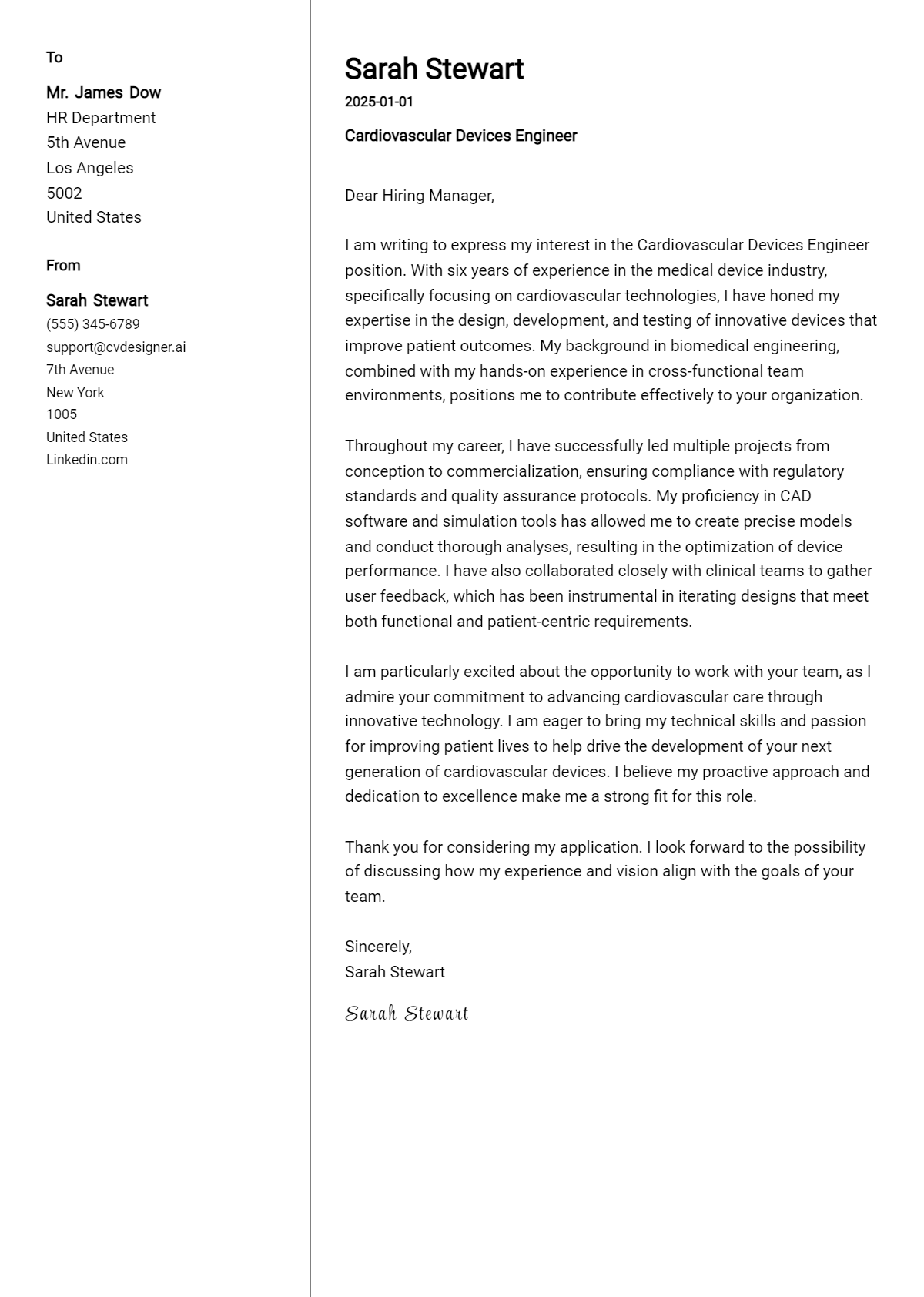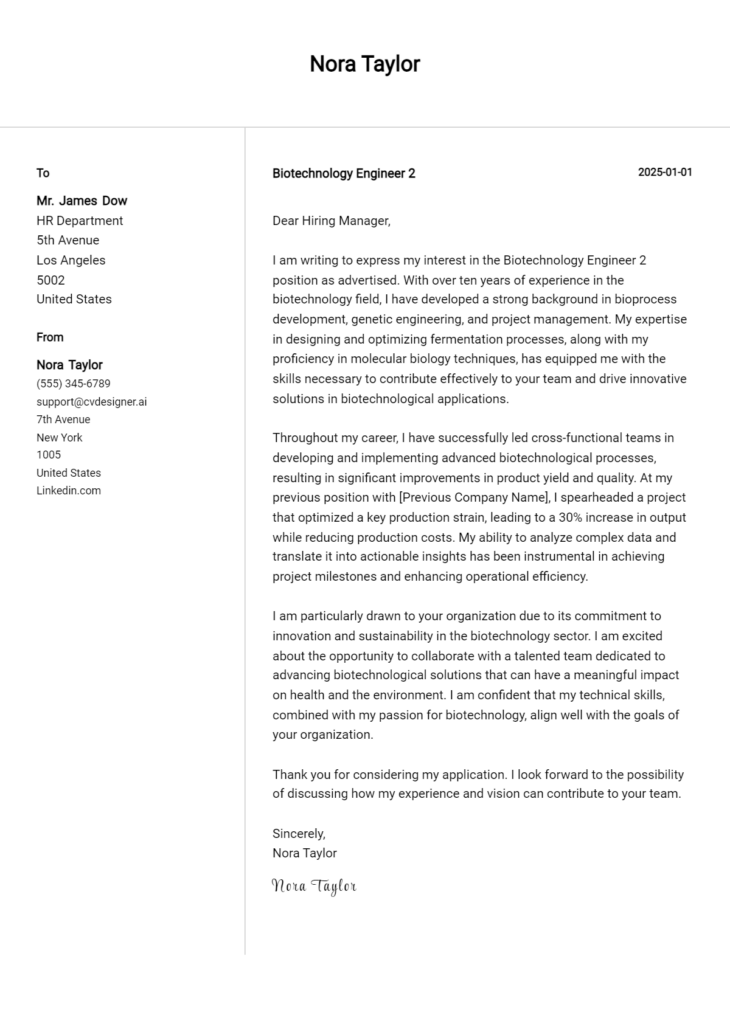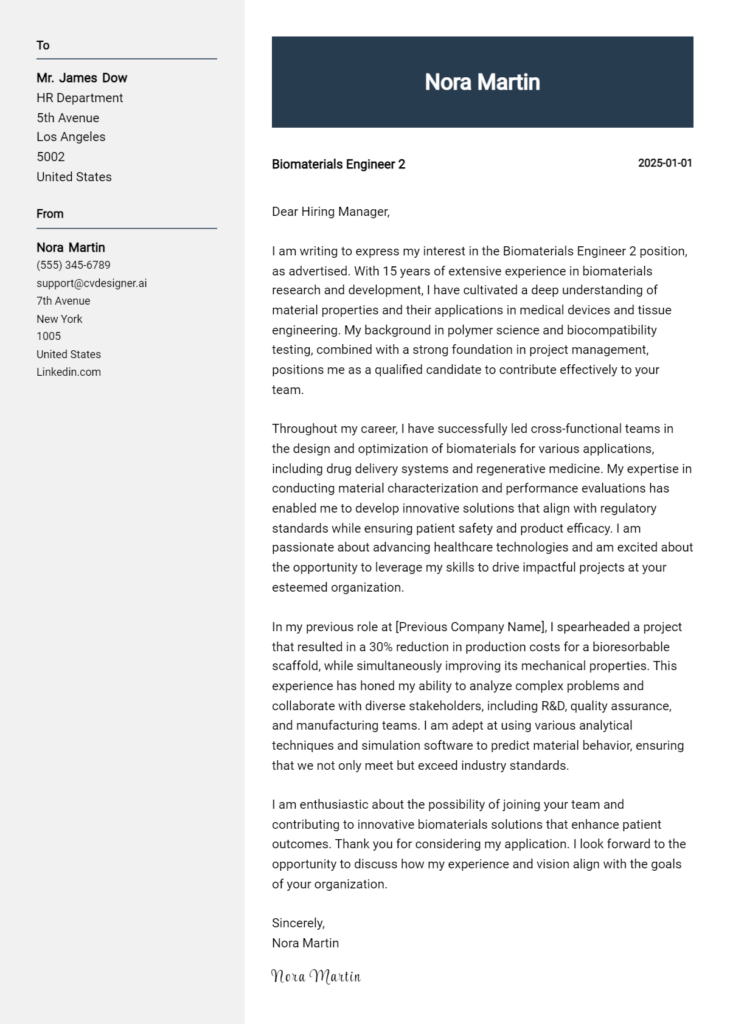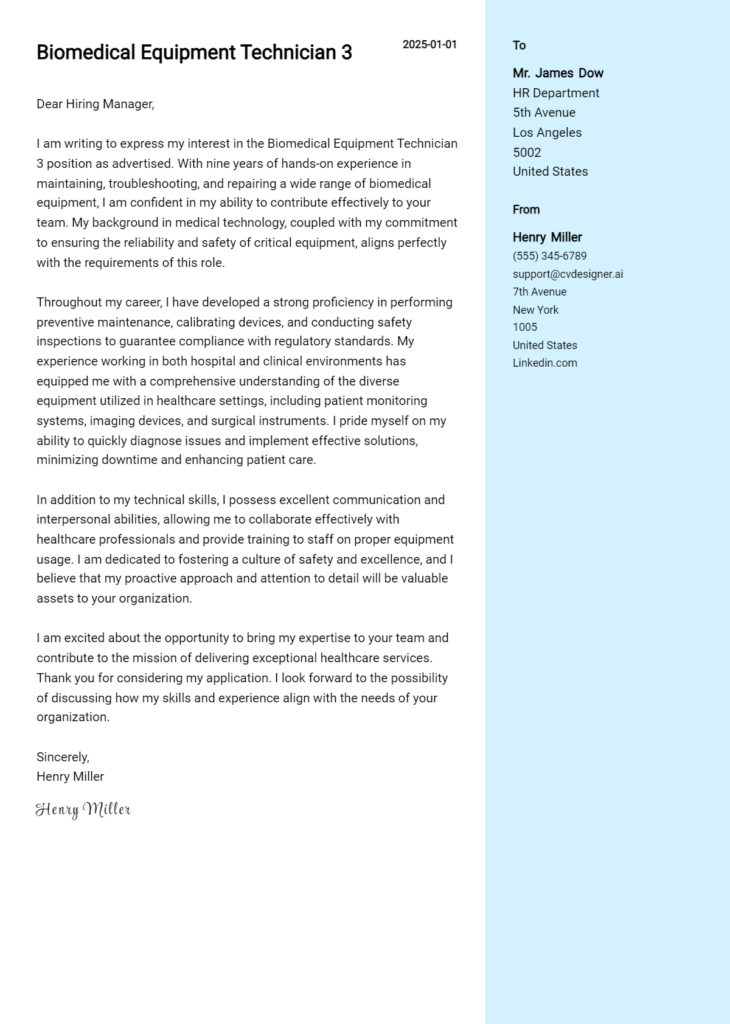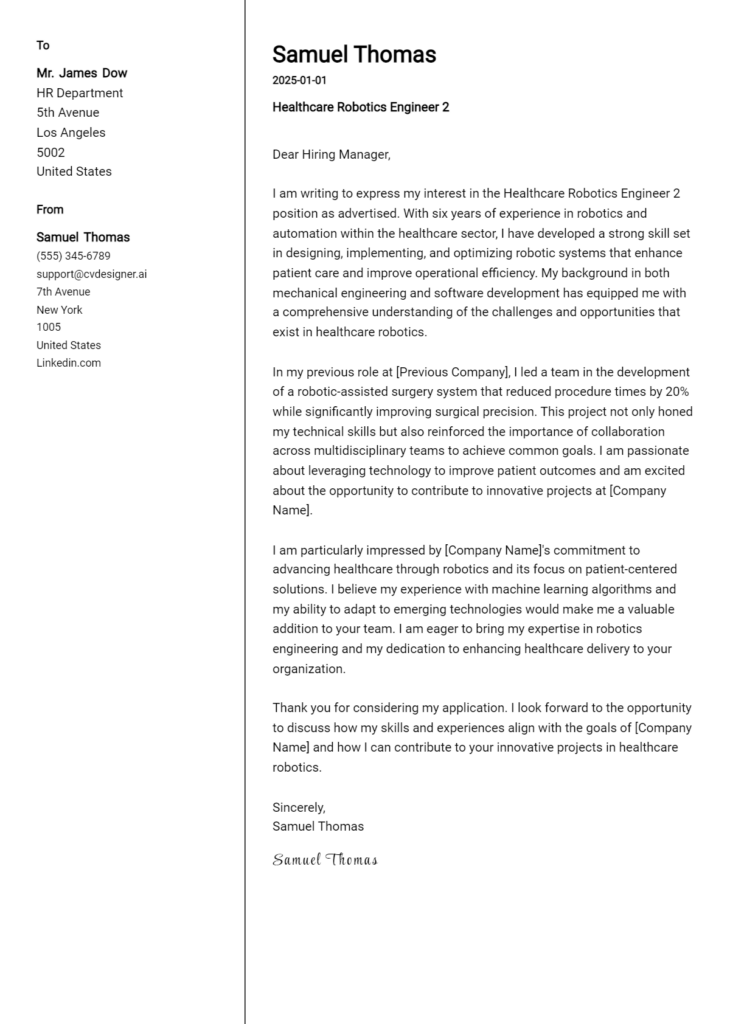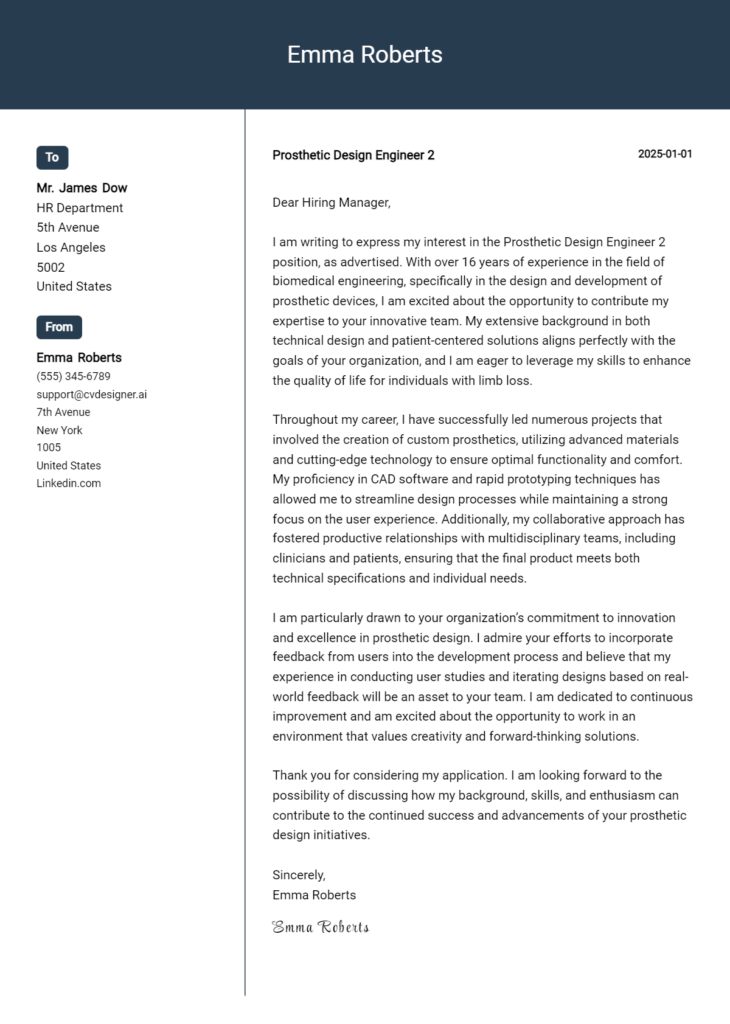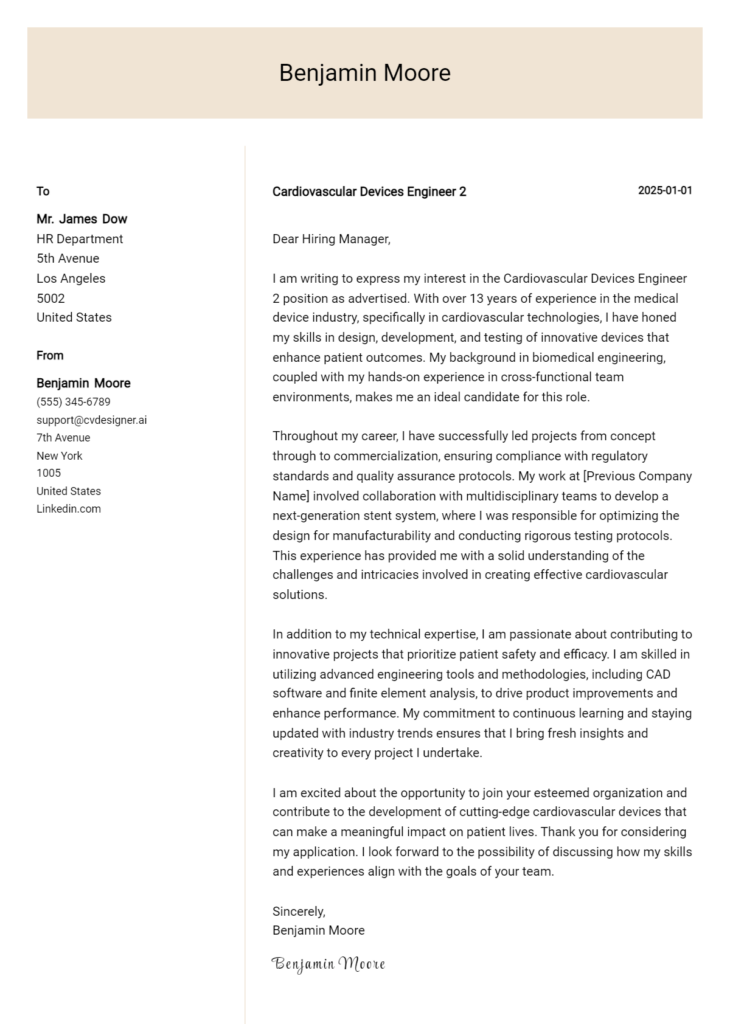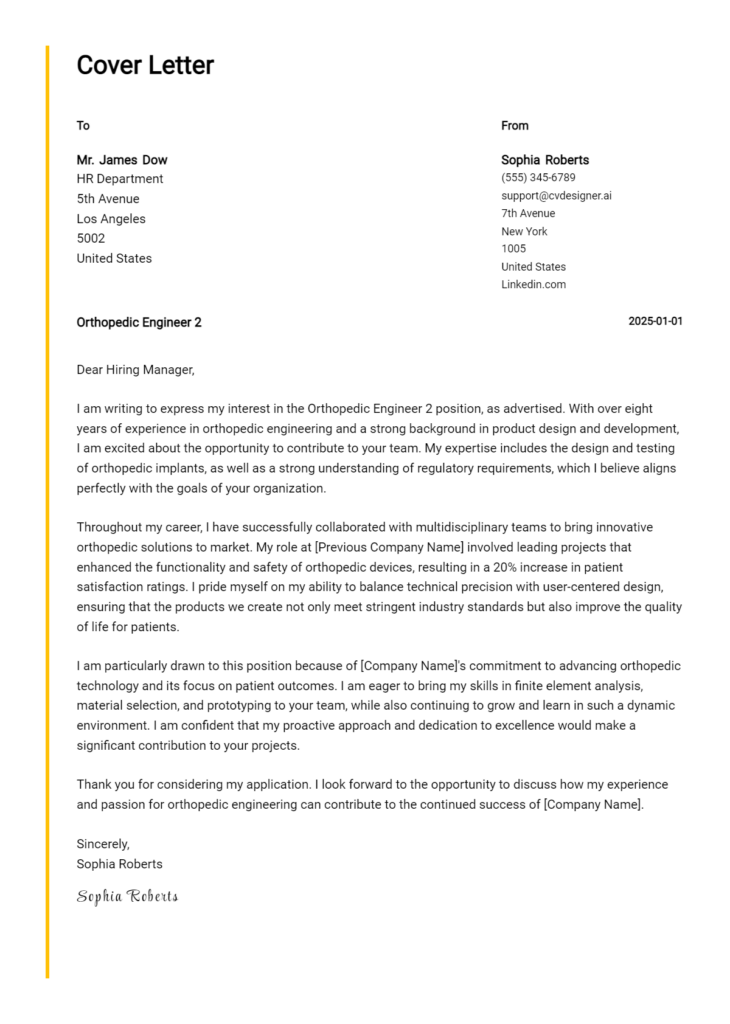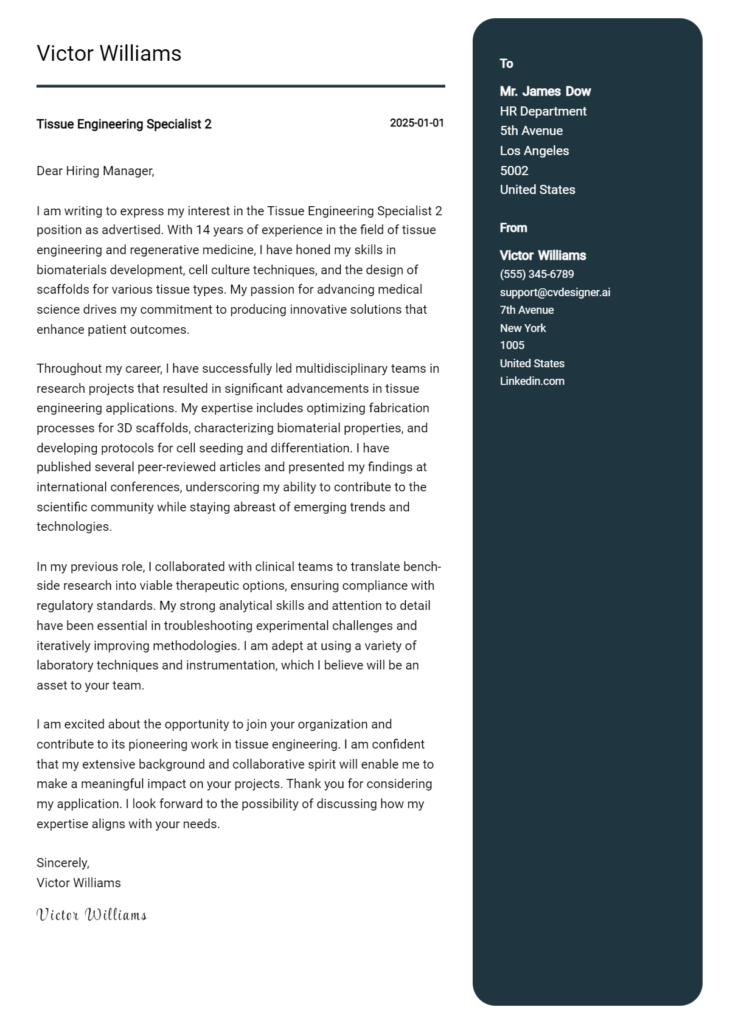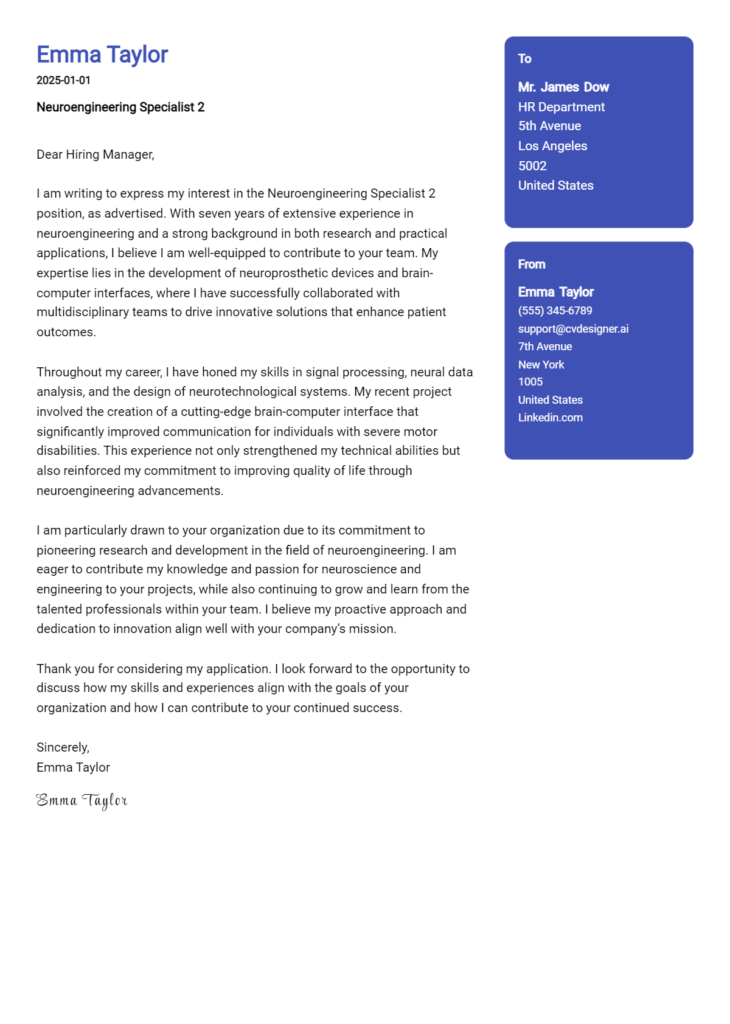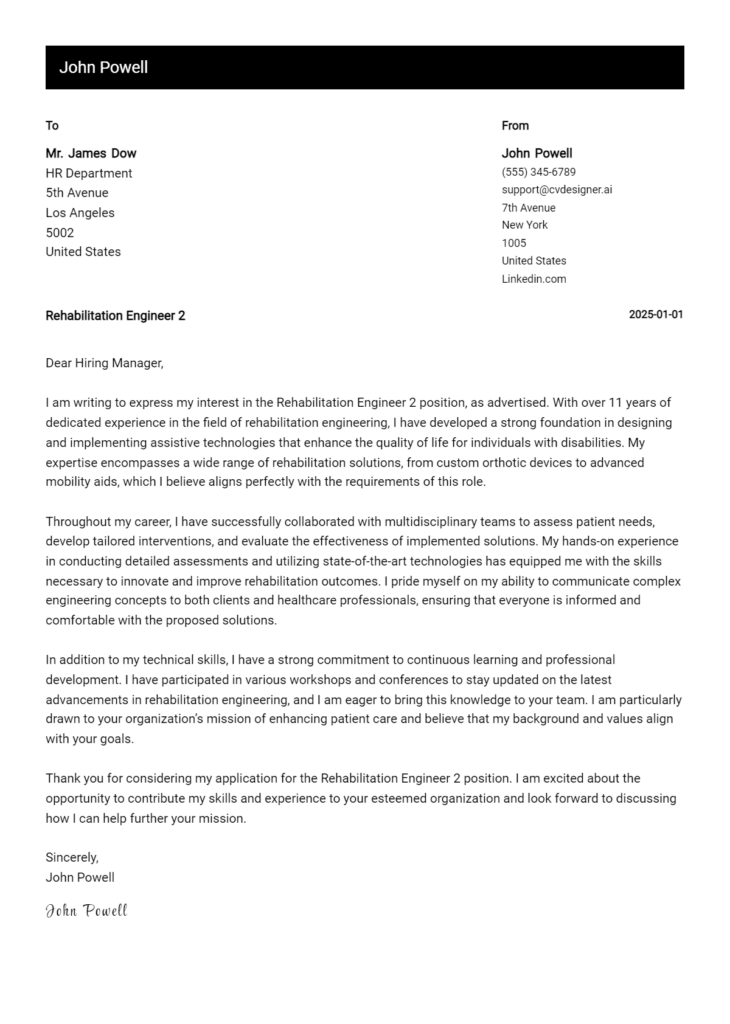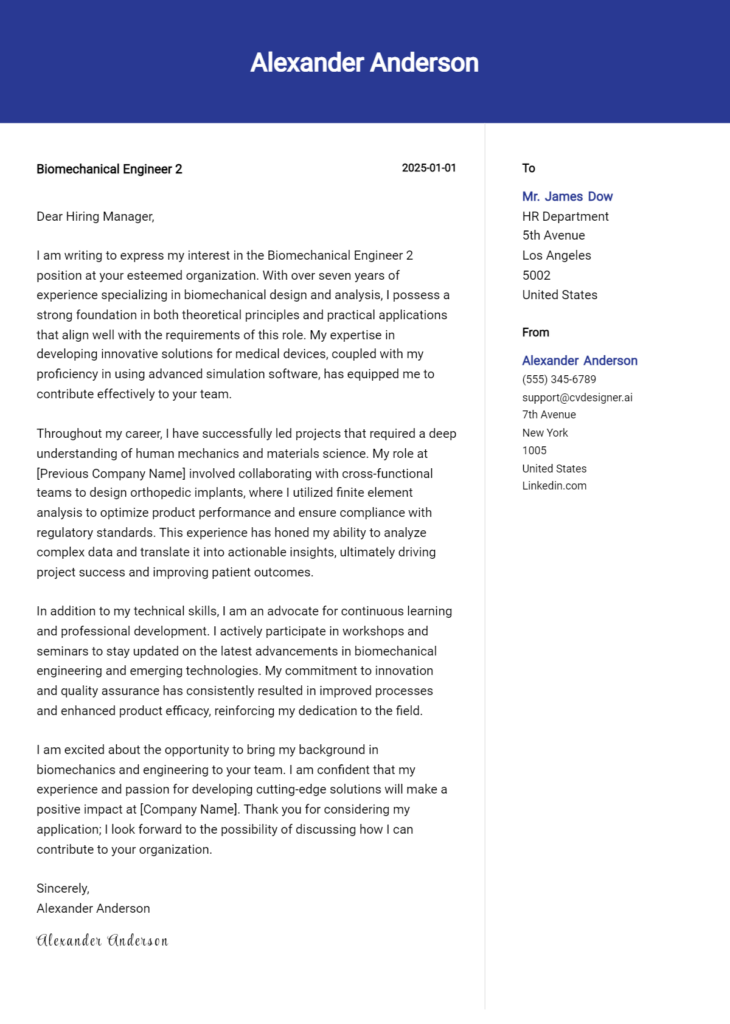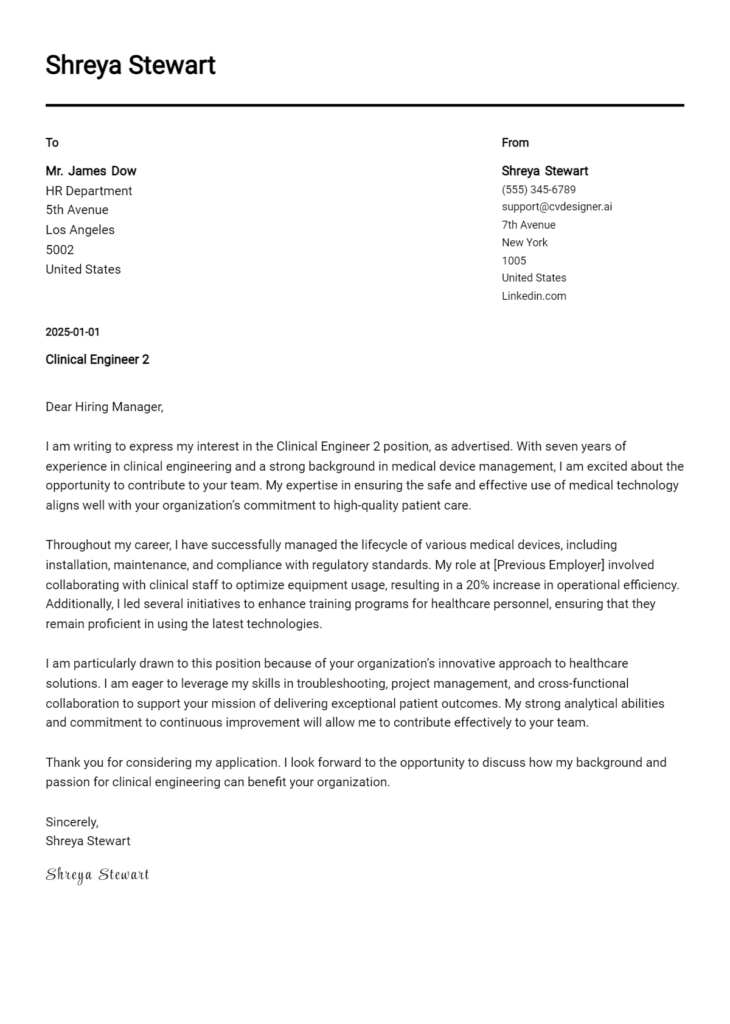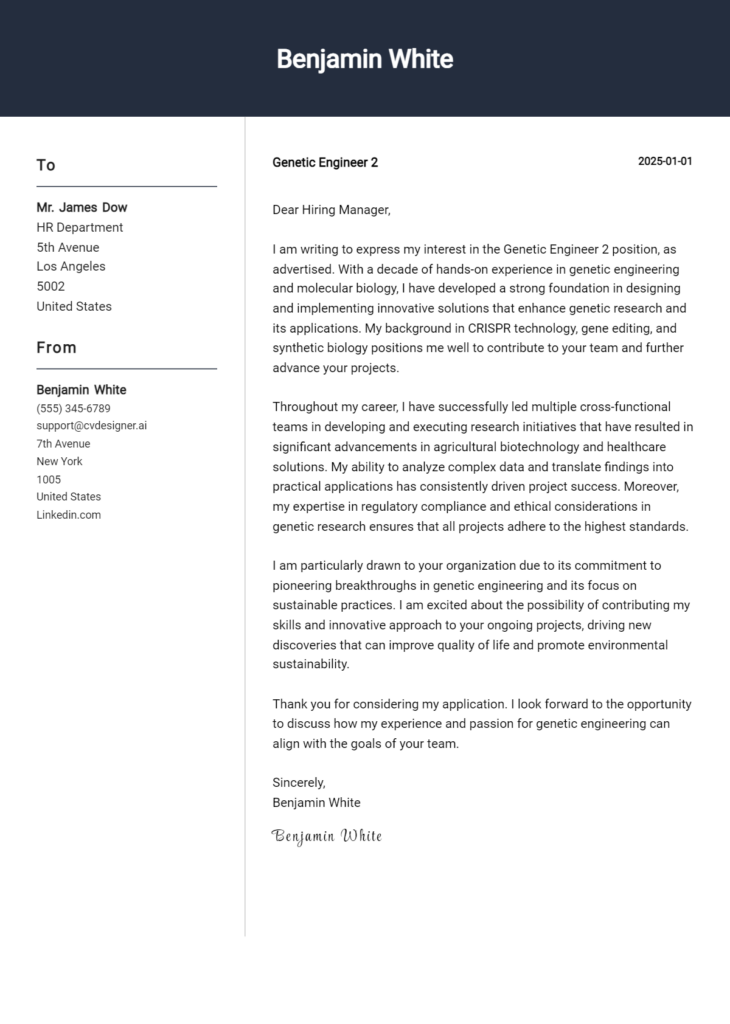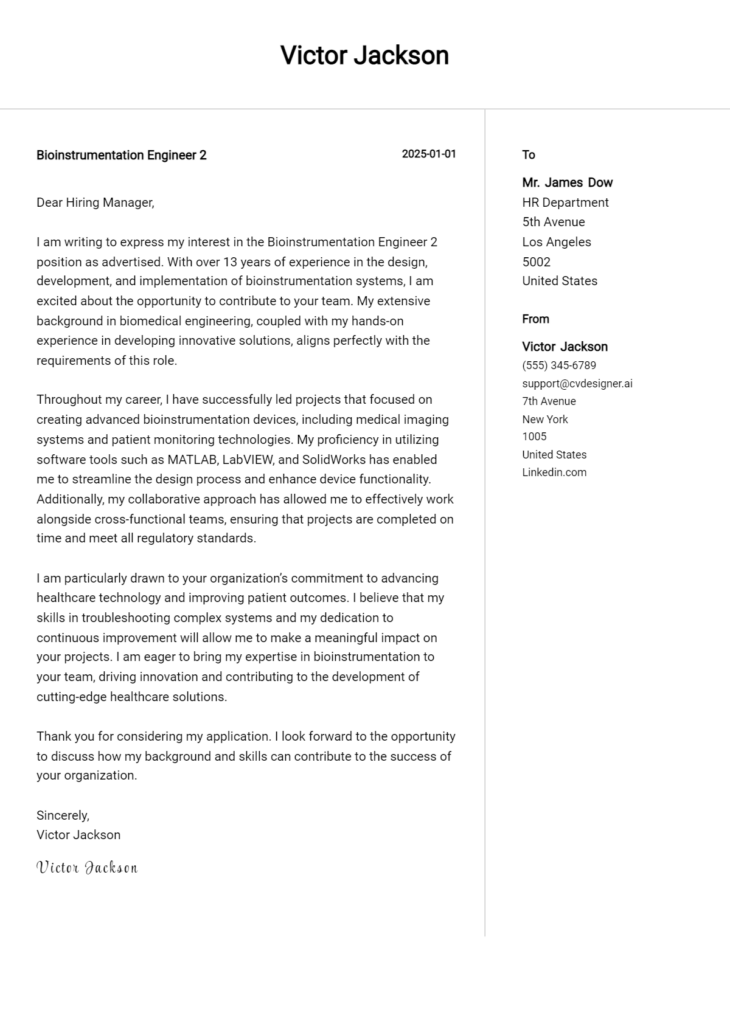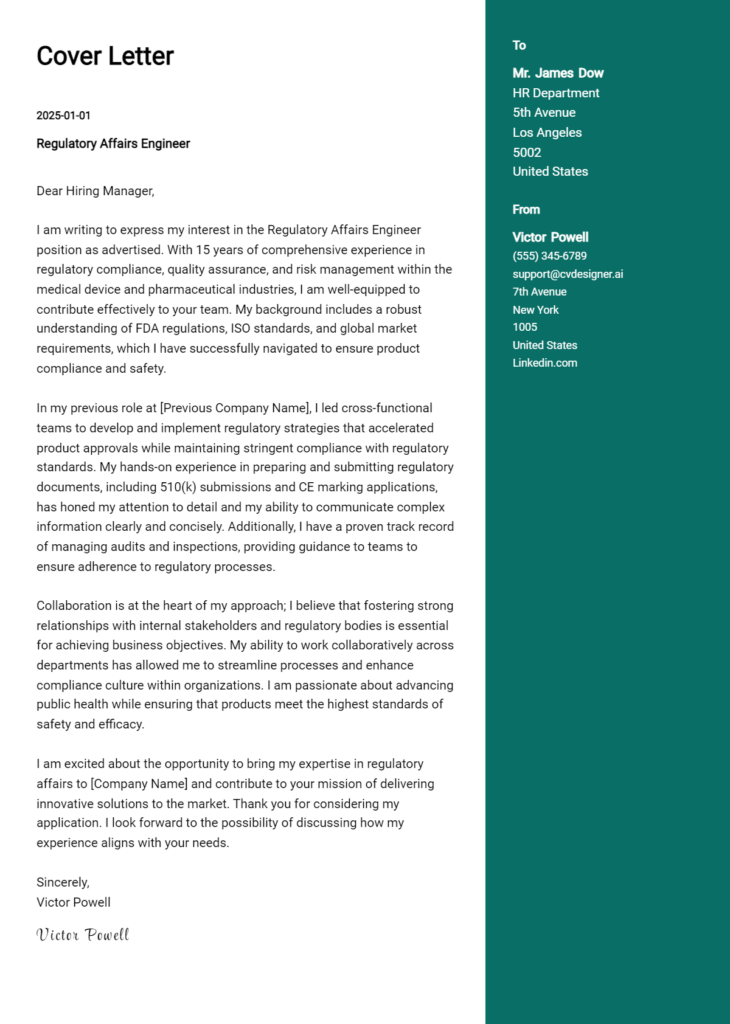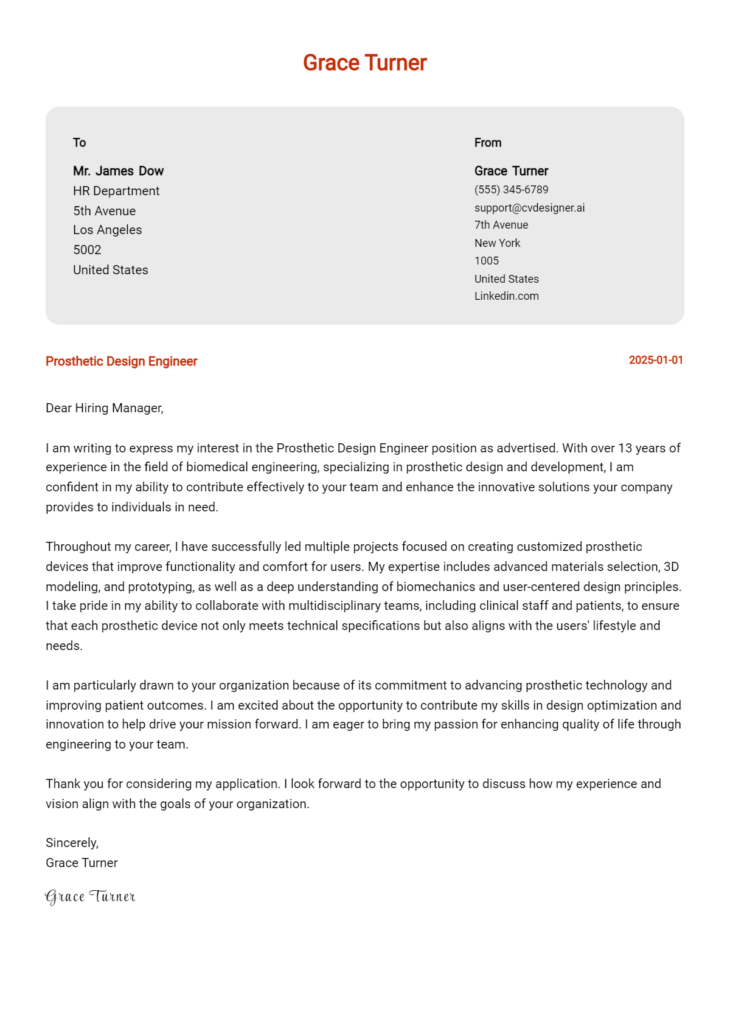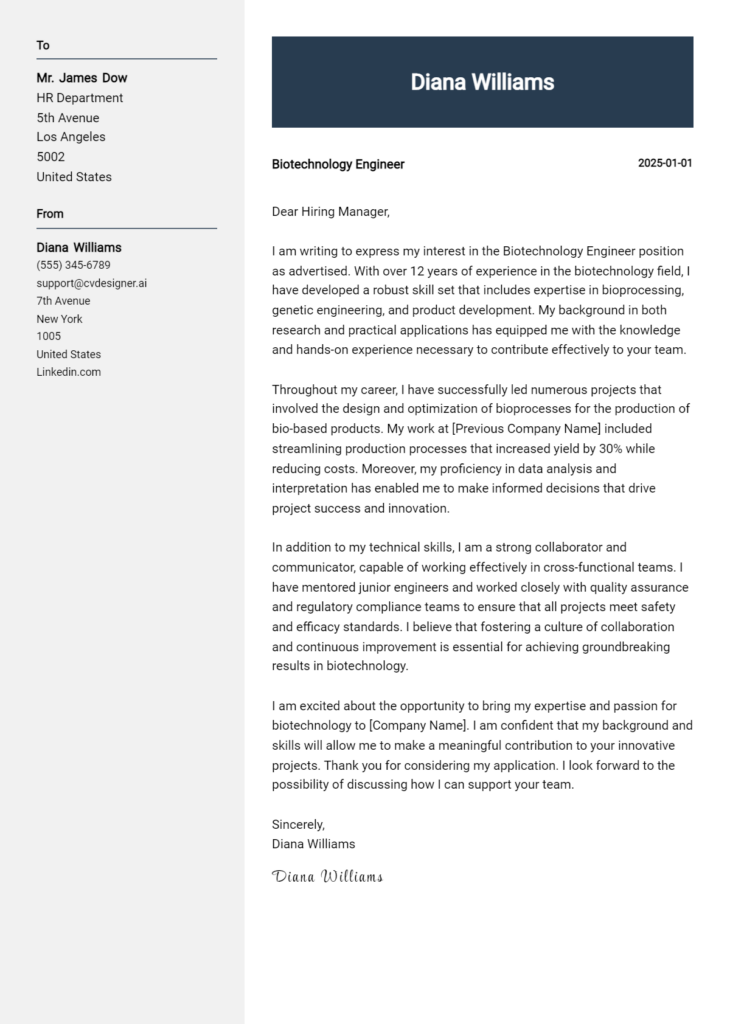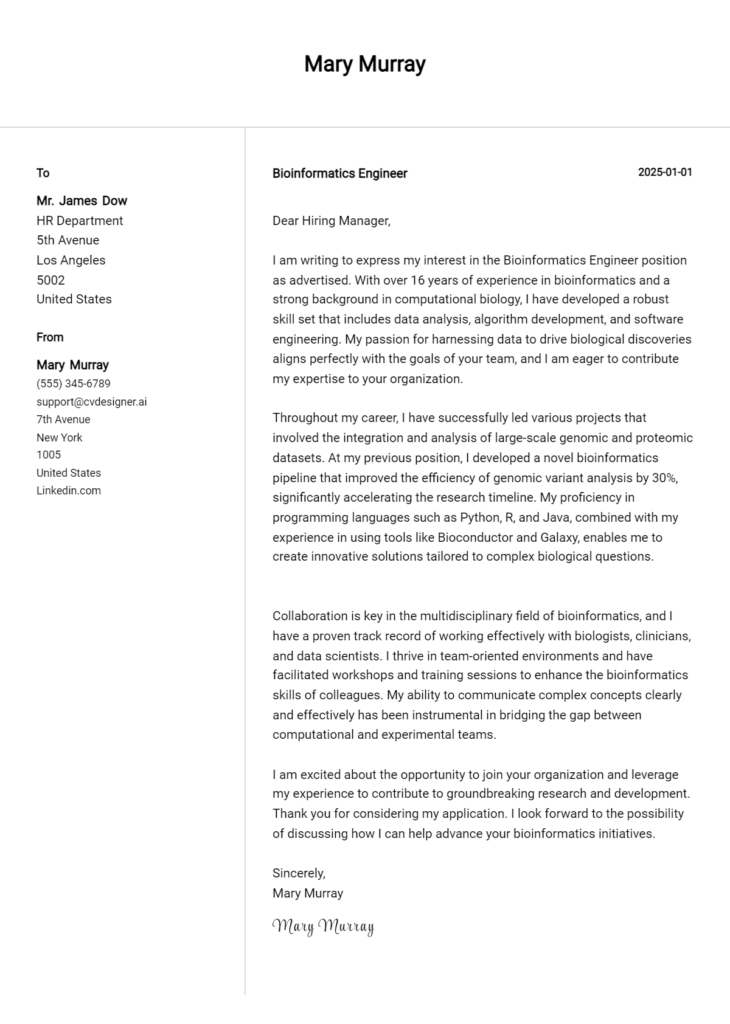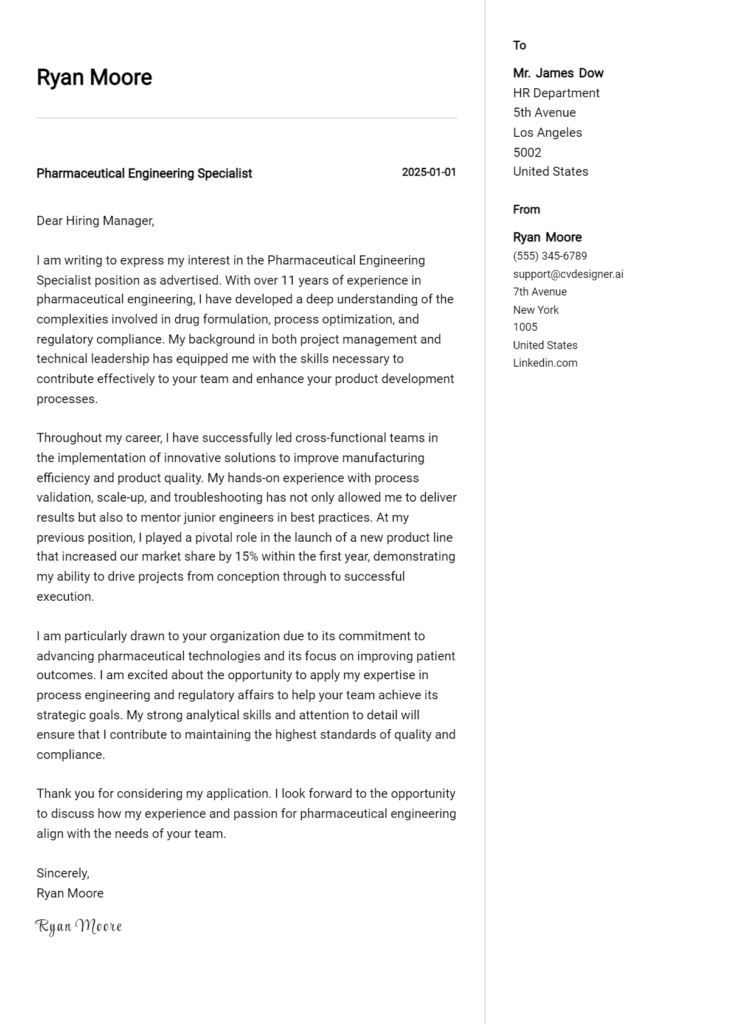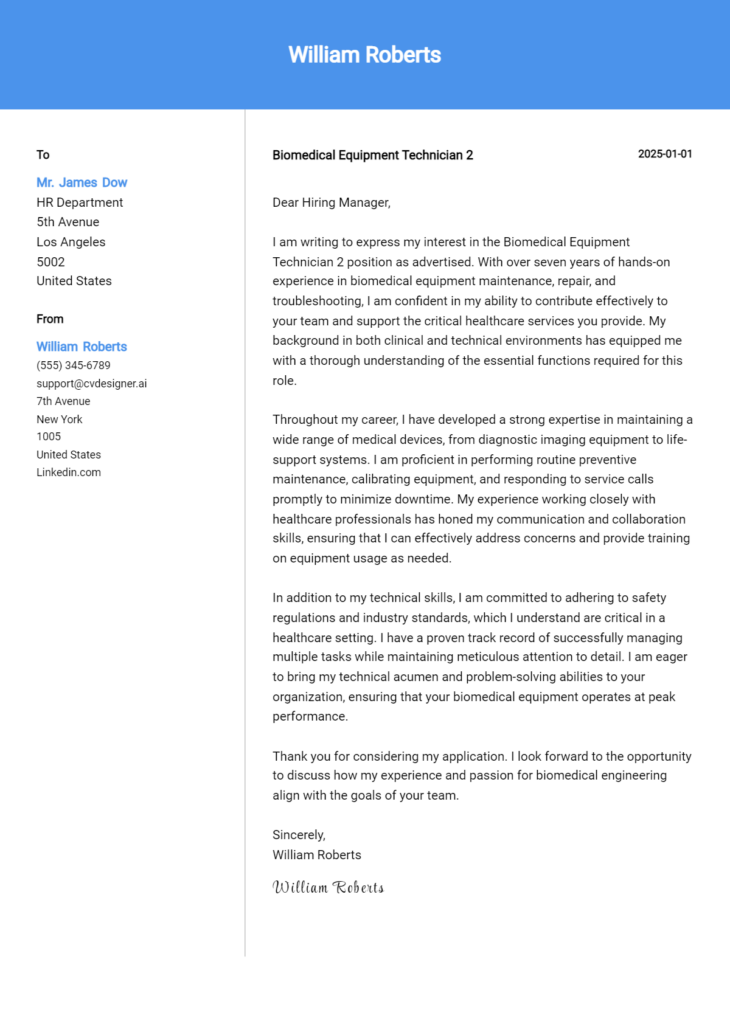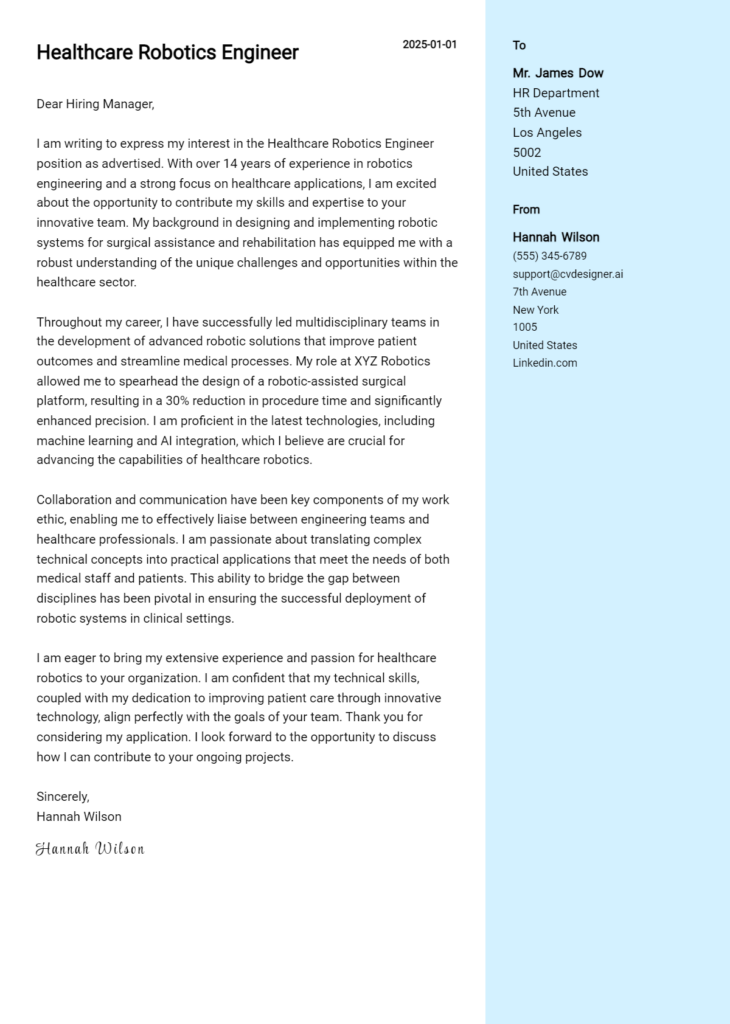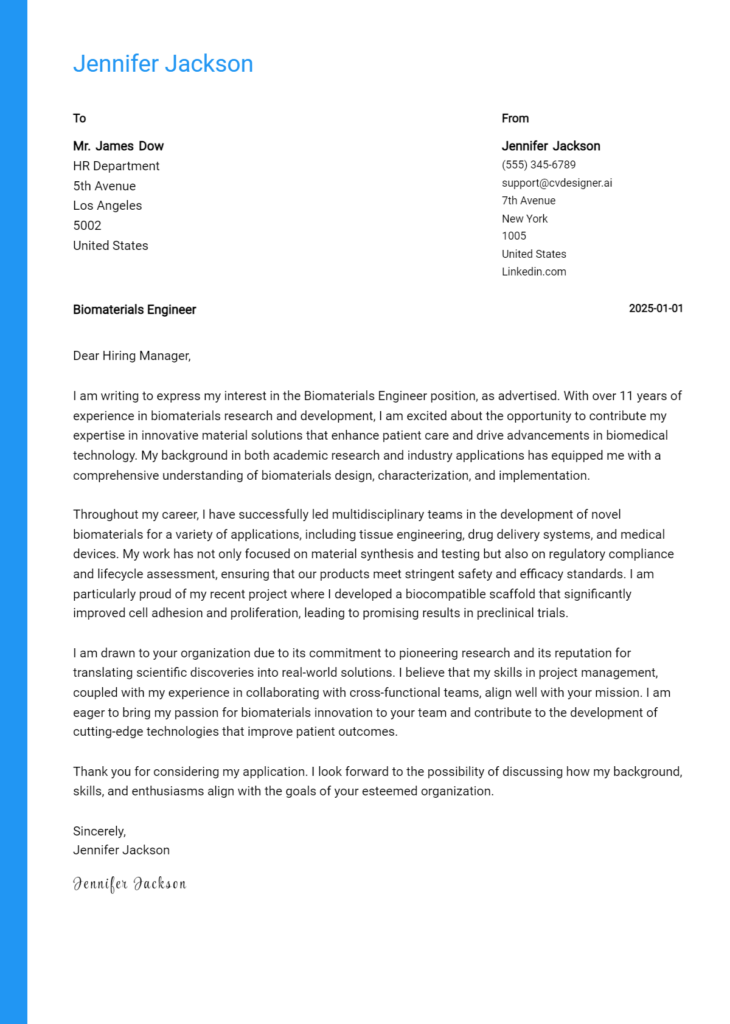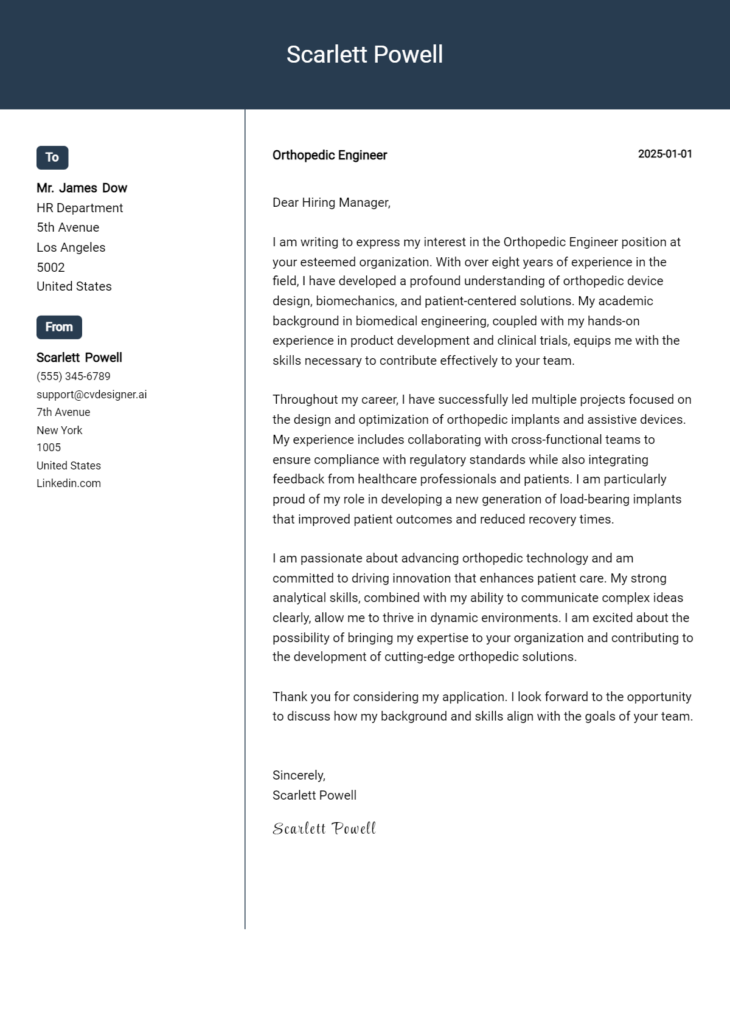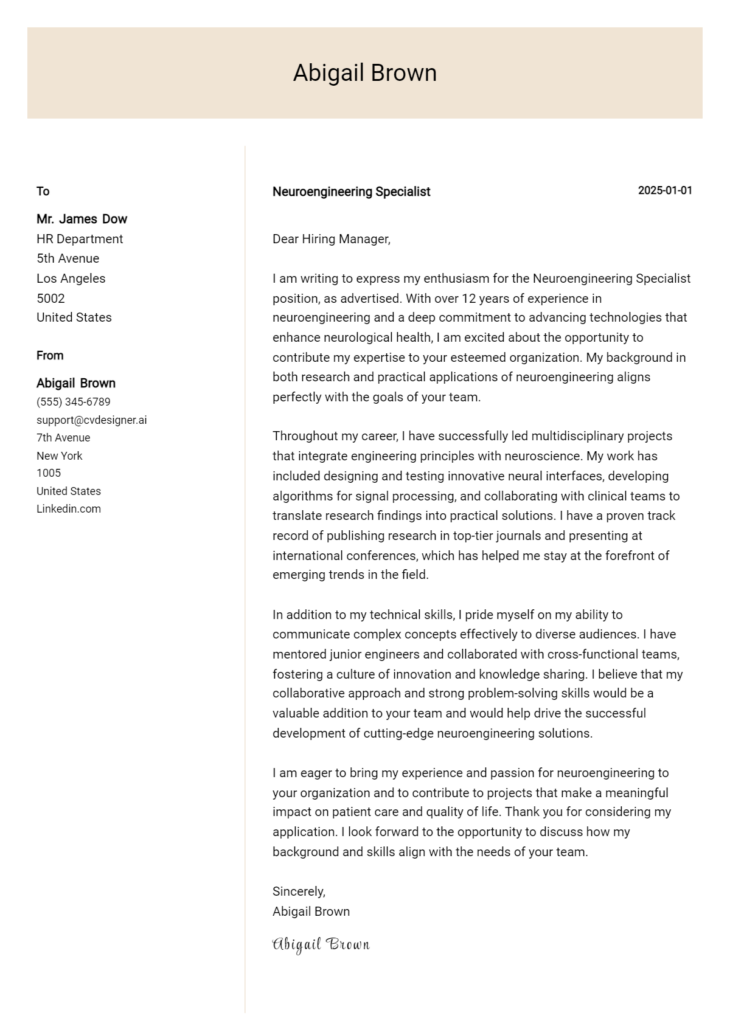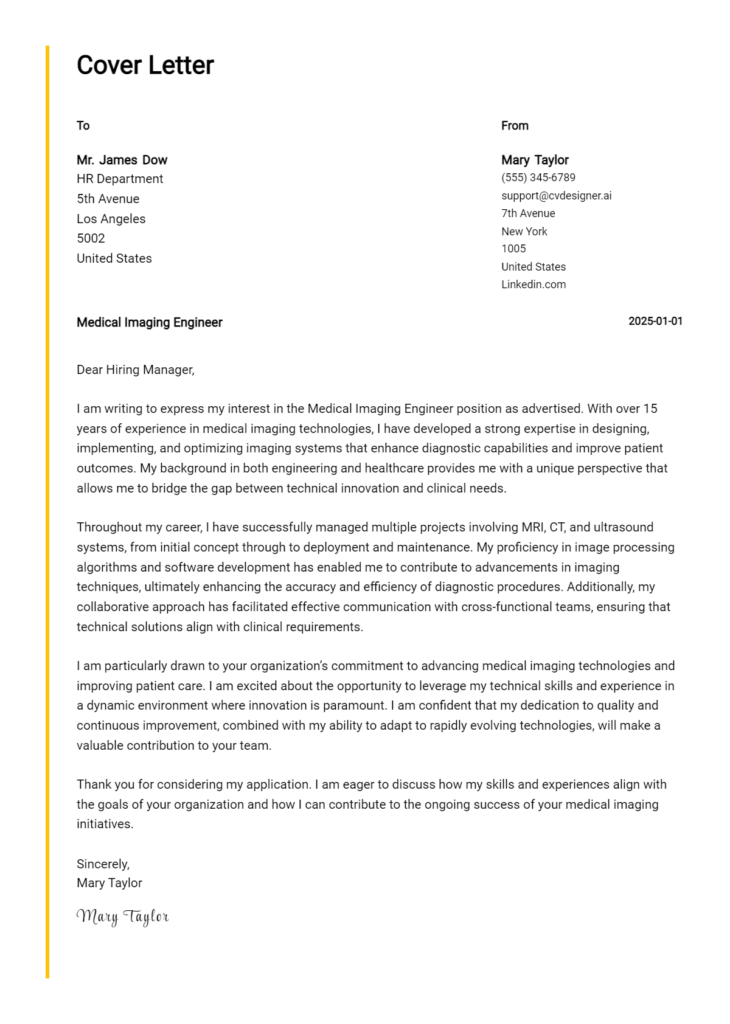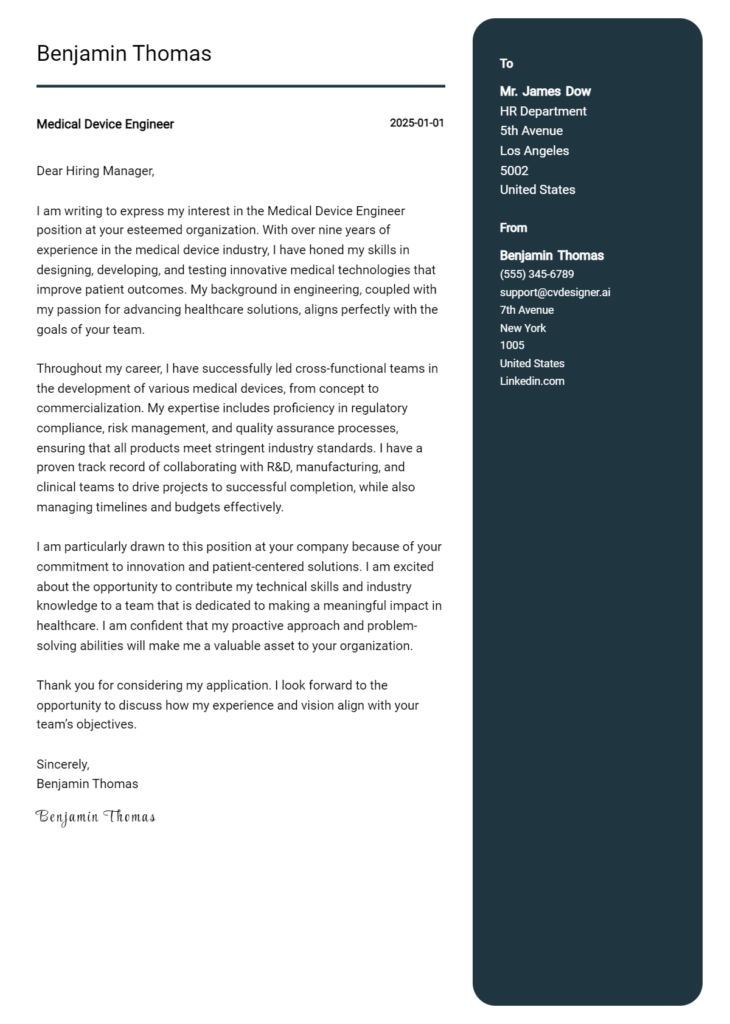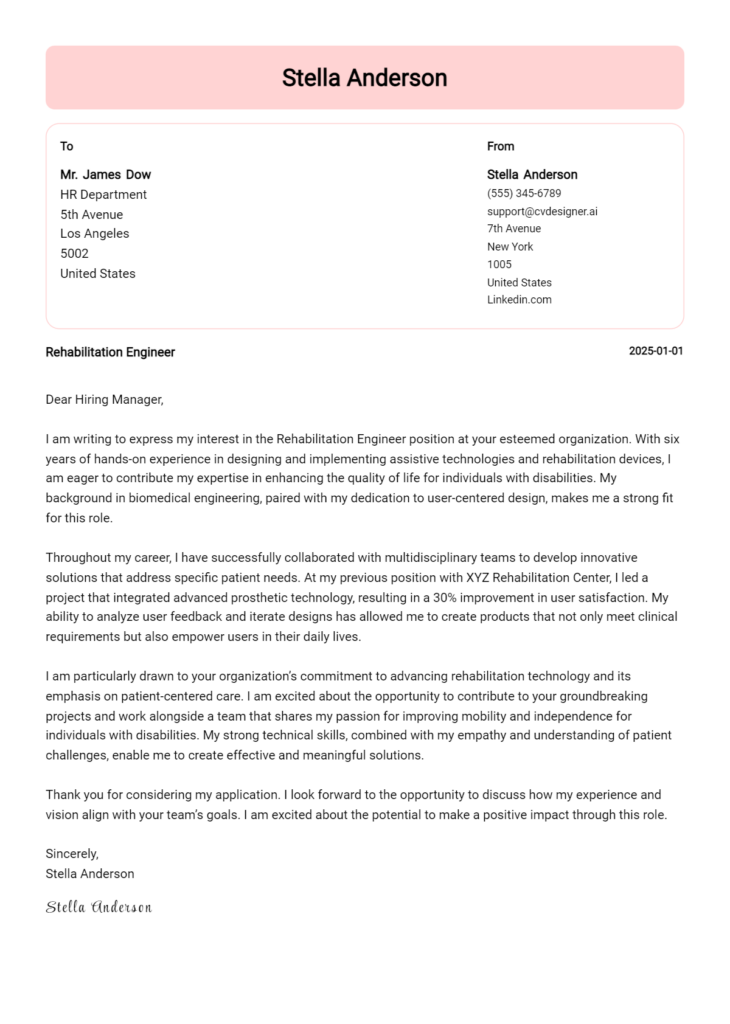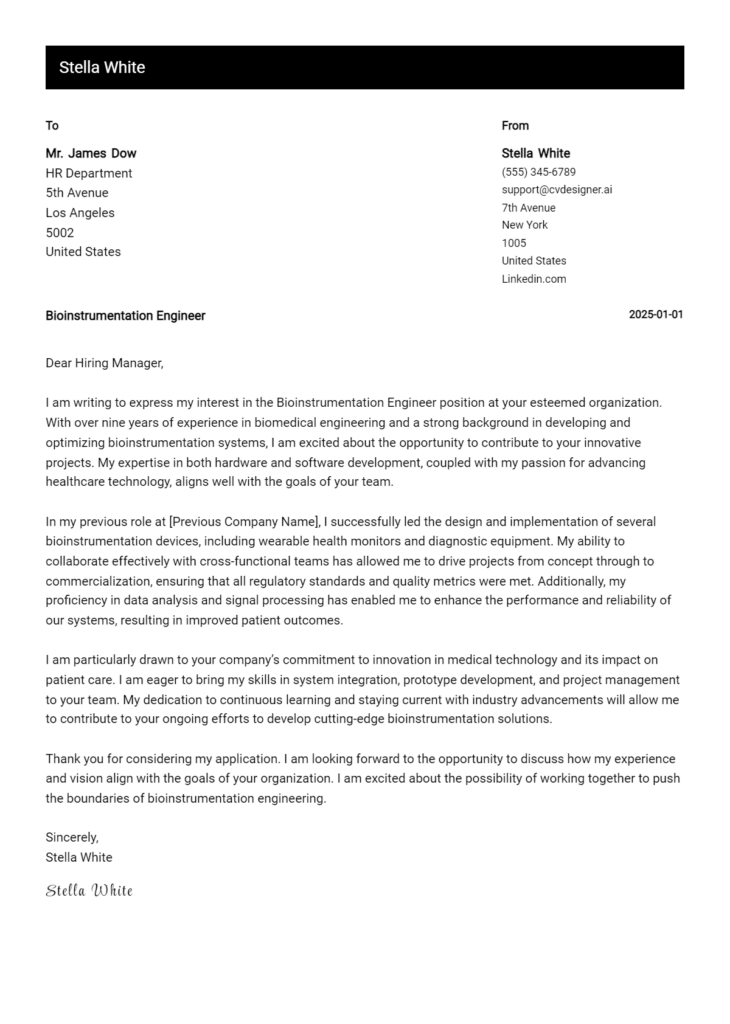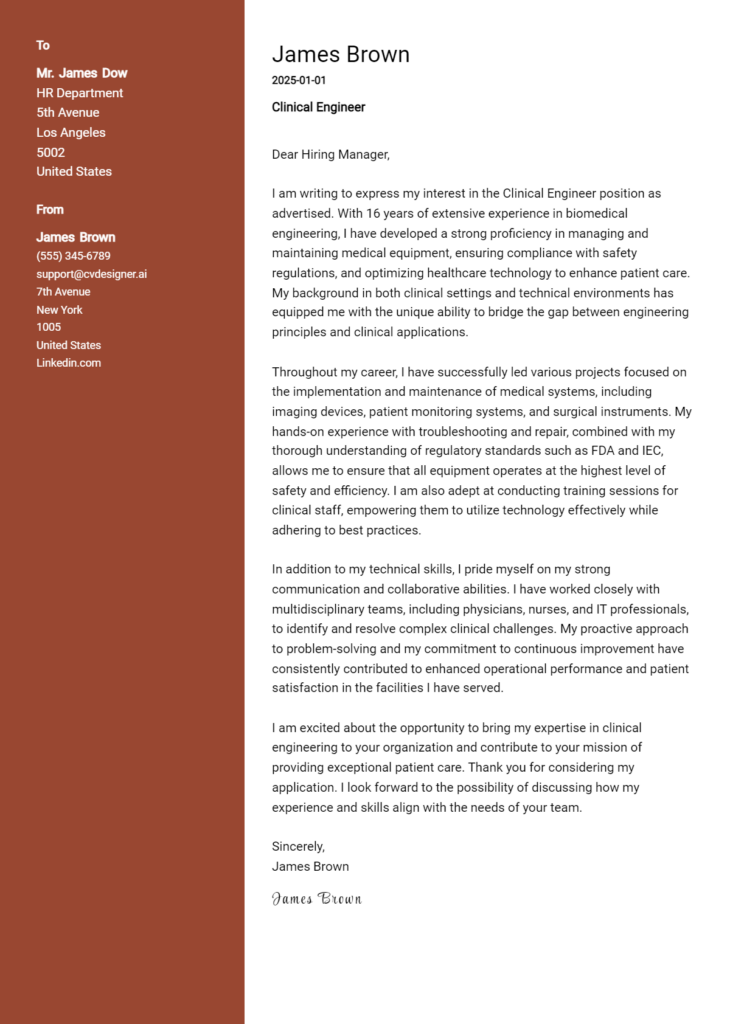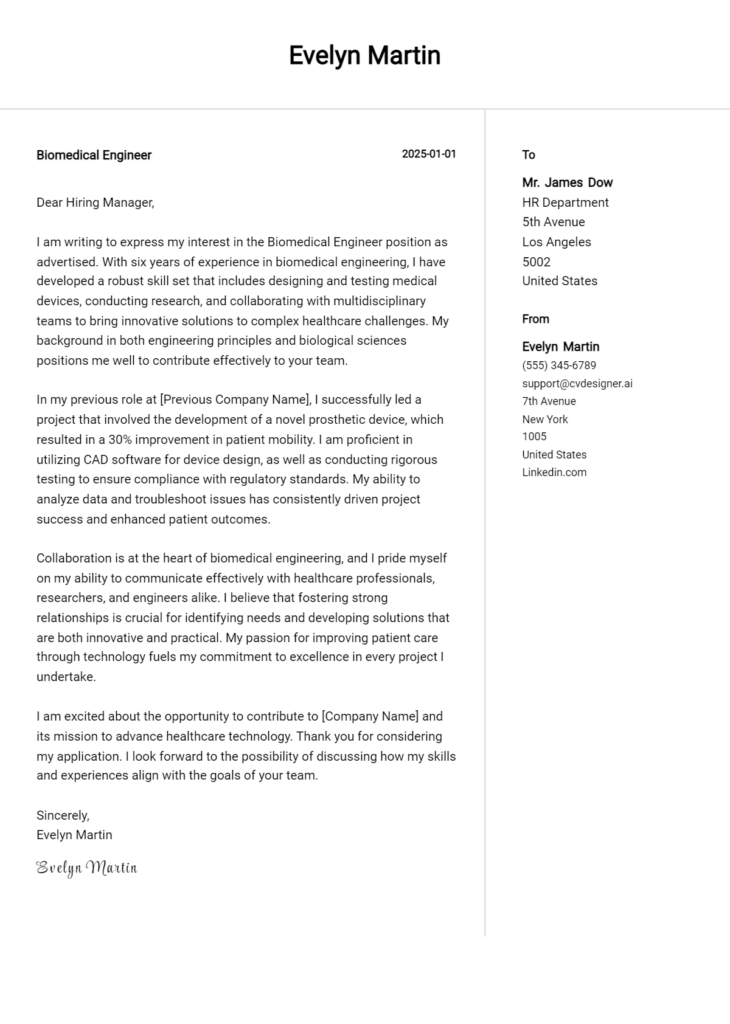Cardiovascular Devices Engineer Cover Letter Examples
Explore additional Cardiovascular Devices Engineer cover letter samples and guides and see what works for your level of experience or role.
How to Format a Cardiovascular Devices Engineer Cover Letter?
Crafting a compelling cover letter is essential for a Cardiovascular Devices Engineer, as it serves as your personal introduction to potential employers. The way you format and present your cover letter not only showcases your technical skills but also reflects your attention to detail, problem-solving abilities, and understanding of the medical technology field. A well-structured cover letter can effectively capture the hiring manager's interest, giving you the opportunity to demonstrate your passion for cardiovascular innovation and patient care.
In this guide, we'll outline how to structure your cover letter, providing insights and examples tailored specifically for cardiovascular device engineering.
We'll focus on the essential components of a professional cover letter, including:
- Cover Letter Header
- Cover Letter Greeting
- Cover Letter Introduction
- Cover Letter Body
- Cover Letter Closing
Each section is pivotal in conveying your qualifications and professionalism. Let’s delve into each part and discover how to make your cover letter truly stand out in the competitive field of cardiovascular devices.
Importance of a Cover Letter Header for a Cardiovascular Devices Engineer
The cover letter header is a critical component of your application as a Cardiovascular Devices Engineer, serving both functional and professional purposes. It establishes your identity and contact information, provides a date for the correspondence, and includes the recipient's details, thereby ensuring clarity and a formal tone. A well-structured header not only reflects your attention to detail but also sets the stage for the content that follows. Clarity and professionalism are paramount, as they convey respect for the hiring manager's time and reinforce your commitment to the role.
Here are examples of a strong and weak cover letter header:
Strong Example
John Doe 1234 Heart Lane Cardio City, CA 90210 john.doe@email.com (123) 456-7890 October 5, 2023 Ms. Jane Smith Hiring Manager Cardiovascular Innovations Inc. 5678 Vascular St. Heartland, CA 90211
Weak Example
JD 555-5555 10/5/21 To Whom It May Concern,
The Importance of a Strong Cover Letter Greeting for Cardiovascular Devices Engineer
The greeting of a cover letter serves as the initial point of contact with the hiring manager and sets the tone for the rest of the letter. A well-crafted greeting not only demonstrates professionalism but also shows a level of personalization that can make a positive impression. By addressing the hiring manager directly, you establish a connection and convey your genuine interest in the position. To enhance this personalization, it's crucial to avoid generic greetings like "To Whom It May Concern" or "Dear Hiring Manager." Instead, take the time to research and find the recipient's name, which can help your application stand out.
Here are some examples of strong and weak greetings for a Cardiovascular Devices Engineer cover letter:
Strong Greeting Example
Dear Ms. Johnson,
Weak Greeting Example
To Whom It May Concern,
The Importance of a Well-Crafted Cover Letter Introduction for a Cardiovascular Devices Engineer
A compelling cover letter introduction is crucial for a Cardiovascular Devices Engineer as it serves as the first impression to the hiring manager. An effective introduction not only captures attention but also conveys genuine interest in the position while highlighting key skills or notable achievements relevant to the role. A strong opening can set the tone for the rest of the letter, encouraging the reader to delve deeper into the candidate's qualifications. Conversely, a weak introduction may leave the hiring manager unimpressed, diminishing the candidate's chances of securing an interview. Below are examples of both strong and weak cover letter introductions for this role.
Strong Example
Dear [Hiring Manager's Name], As a dedicated and innovative Cardiovascular Devices Engineer with over five years of experience in the design and development of cutting-edge medical devices, I am excited to apply for the [Job Title] position at [Company Name]. My passion for improving patient outcomes through advanced technology, combined with my successful track record of launching several FDA-approved devices, makes me an ideal candidate for your team. I am particularly drawn to [Company Name] due to its commitment to innovation and excellence in cardiovascular healthcare.
Weak Example
To whom it may concern, I am writing to apply for the Cardiovascular Devices Engineer position. I have a degree in engineering and some experience in the medical field. I believe I could be a good fit for this job because I like working with technology.
Purpose of the Cover Letter Body for a Cardiovascular Devices Engineer
The cover letter body serves as a critical component in presenting a Cardiovascular Devices Engineer's qualifications, skills, and unique contributions to potential employers. This section allows the candidate to detail specific projects and accomplishments that demonstrate their expertise in designing, developing, and testing cardiovascular devices. By highlighting relevant experiences, such as successful collaborations in cross-functional teams, innovative design solutions, or improvements in device performance and patient outcomes, the candidate can effectively illustrate their value to the organization and align their skills with the company’s goals.
Strong Example
Dear Hiring Manager, As a Cardiovascular Devices Engineer with over five years of experience in the design and development of innovative medical devices, I am excited to apply for the position at your esteemed company. In my previous role at XYZ Medical, I led a cross-functional team in the development of a novel stent design that reduced thrombosis rates by 30%. This project not only enhanced patient safety but also received FDA approval six months ahead of schedule. I am particularly proud of my ability to collaborate with cardiologists and regulatory experts to ensure our designs met clinical needs and compliance standards. I believe my technical skills in CAD software and my passion for improving patient outcomes make me a perfect fit for your team.
Weak Example
Dear Hiring Manager, I am writing to apply for the Cardiovascular Devices Engineer position. I have some experience in engineering and have worked on a few projects related to medical devices. I am good at solving problems and am proficient in software tools. I think I would do well in this position because I want to help people. I have not worked on any specific projects that achieved notable results, but I am eager to learn and contribute to your company.
Importance of the Cover Letter Closing for a Cardiovascular Devices Engineer
The closing of a cover letter is a critical component, particularly for a Cardiovascular Devices Engineer, as it serves to summarize key qualifications, reaffirm enthusiasm for the position, and prompt the hiring manager to take action, such as reviewing the resume or scheduling an interview. A strong closing leaves a memorable impression and emphasizes the candidate's fit for the role, while a weak closing may fail to convey confidence or initiative. Below are examples illustrating both strong and weak closings.
Strong Example
Thank you for considering my application for the Cardiovascular Devices Engineer position. With my extensive experience in designing and testing innovative cardiovascular solutions, along with my passion for advancing patient care, I am excited about the opportunity to contribute to your team. I look forward to discussing how my background and skills align with your needs. Please feel free to review my attached resume, and I hope to schedule an interview soon to discuss my application further.
Weak Example
Thanks for looking at my cover letter. I think I could be a good fit for the job. I hope you like my resume and maybe we can talk later.
These tips will assist candidates in crafting an effective cover letter for a Cardiovascular Devices Engineer position. A well-written cover letter is essential for standing out in a competitive field, and it should clearly demonstrate your technical skills, problem-solving abilities, understanding of the Software Development Life Cycle (SDLC), teamwork capabilities, and a passion for continuous learning. Here are five detailed tips to help you create an impactful cover letter.
Tips for Writing a Cover Letter for a Cardiovascular Devices Engineer
Highlight Technical Expertise
Make sure to emphasize your technical skills relevant to cardiovascular devices. Discuss specific technologies, tools, or software you are proficient in, such as CAD software, simulation tools, or programming languages. Providing concrete examples of how you've applied these skills in past projects can enhance your credibility. Consider using cover letter templates to structure this section effectively.Demonstrate Problem-Solving Abilities
Employers are looking for engineers who can tackle complex challenges. Share specific instances where you identified a problem in a project and how you approached finding a solution. Use quantifiable results to illustrate your impact, such as improving device efficiency or reducing development time.Showcase SDLC Knowledge
Highlight your understanding of the Software Development Life Cycle. Detail your experience in each phase, from requirements gathering to testing and deployment. This can demonstrate your comprehensive knowledge of the processes involved in developing cardiovascular devices, making you a more attractive candidate.Emphasize Teamwork and Collaboration
Cardiovascular devices are often developed by interdisciplinary teams. Discuss your experience working in collaborative environments, showcasing your ability to communicate effectively with engineers, designers, regulatory teams, and other stakeholders. Provide examples that illustrate your role in successful team projects.Express a Passion for Continuous Learning
The field of cardiovascular devices is constantly evolving. Convey your commitment to staying updated with industry advancements, whether through professional development courses, certifications, or participation in relevant conferences. This shows employers that you are proactive and dedicated to your growth in the field. You can even mention using a cover letter builder to refine your cover letter as part of your commitment to continuous improvement.
By focusing on these key areas, you will be able to create a compelling cover letter that effectively showcases your qualifications for the role of a Cardiovascular Devices Engineer.
Common Mistakes to Avoid in a Cardiovascular Devices Engineer Cover Letter
Avoiding common mistakes in your cover letter is crucial for standing out in the competitive field of cardiovascular device engineering. A well-crafted cover letter can make a significant difference in your job application, while errors can undermine your qualifications and professionalism. Here are some common pitfalls to watch for:
Generic Greetings: Using "To Whom It May Concern" or similar phrases can make your letter feel impersonal. Instead, try to find the name of the hiring manager or use a specific title if you can't.
Lack of Specificity: Failing to mention specific projects, experiences, or skills relevant to cardiovascular devices may lead to a lack of connection with the role. Tailor your cover letter to highlight your expertise in this niche.
Overloading with Technical Jargon: While it's important to showcase your knowledge, too much technical jargon can alienate readers. Balance technical terms with clear explanations to ensure your letter is accessible.
Neglecting the Job Description: Not aligning your cover letter with the job description can result in missed opportunities to showcase your fit. Reference specific qualifications and experiences that match the requirements listed in the posting.
Poor Formatting: A cluttered or unprofessional format can detract from your message. Follow a clear cover letter format to ensure readability and a polished appearance.
Spelling and Grammar Errors: Simple mistakes can create a negative impression. Always proofread your cover letter multiple times and consider using tools to catch errors.
Repeating Your Resume: Your cover letter should complement your resume, not replicate it. Use this space to share insights about your motivation, passion for the field, and unique contributions you can make to the team.
By steering clear of these common mistakes, you can create a compelling cover letter that enhances your application and showcases your qualifications for a role as a Cardiovascular Devices Engineer. For further inspiration, check out these cover letter examples to spark your creativity.
Cover Letter FAQs for Cardiovascular Devices Engineer
What should I include in my cover letter as a Cardiovascular Devices Engineer?
In your cover letter, it's crucial to highlight your technical skills and experience relevant to cardiovascular devices. Begin by introducing yourself and stating your interest in the position. Emphasize your educational background in biomedical engineering or a related field. Discuss specific projects or roles where you designed, tested, or improved cardiovascular devices, showcasing your familiarity with industry standards and regulations. Include any relevant certifications or training that demonstrate your commitment to the field. Finally, convey your passion for advancing healthcare technologies and how you can contribute to the company's goals.
How do I tailor my cover letter for a specific job application?
To tailor your cover letter, start by thoroughly reading the job description and identifying key requirements. Highlight your most relevant experiences and skills that align with those requirements. Use specific examples from your past work, such as successful projects or challenges you’ve overcome in cardiovascular device development. Incorporate keywords from the job listing into your cover letter to make it clear that you understand the role. Additionally, research the company’s mission and values, and express how your professional goals align with theirs. This personalized approach demonstrates your genuine interest in the position.
How long should my cover letter be?
Your cover letter should ideally be one page long, typically around 250-400 words. This length allows you to convey essential information without overwhelming the reader. Focus on being concise and clear while highlighting your most relevant experiences and skills. Use short paragraphs and bullet points where appropriate to enhance readability. Remember that hiring managers often review multiple applications, so being succinct while still providing essential details about your qualifications is crucial. A well-structured cover letter will effectively capture attention and make a strong impression.
What tone should I use in my cover letter?
In your cover letter, aim for a professional yet approachable tone. Use formal language that reflects your expertise in cardiovascular devices, but avoid overly technical jargon that may alienate the reader. Show enthusiasm for the role and the company by expressing your genuine interest in contributing to their success. Balance professionalism with a touch of personality to help your letter stand out. Remember to maintain a respectful tone throughout and conclude with a courteous closing statement, thanking the hiring manager for their consideration and expressing your eagerness for an interview.
Build your Cover Letter in minutes
Use an AI-powered cover letter builder and have your letter done in 5 minutes. Just select your template and our software will guide you through the process.

